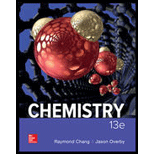
Some reactions are described as parallel in that the reactant simultaneously forms different products with different rate constants. An example is
and
The activation energies are 45.3 kJ/mol for k1 and 69.8 kJ/mol for k2. If the rate constants are equal at 320 K, at what temperature will k1/k2 = 2.00?
Interpretation:
If the rate constants of given reactions are equal at
Concept introduction:
Arrhenius equation:
Arrhenius equation is a formula that represents the temperature dependence of reaction rates
The Arrhenius equation can be represented as follows
R represents the universal gas constant and it has the value of 8.314 J/K.mol
T represents the absolute temperature
If two rate constants at two temperture are known then the activation energy
Explanation of Solution
Some reactions are described as parallel in that the reactant simultaneously forms different products with different rate constants. Given example for such type of reactions are,
Activation energy for
If the rate constants of given reactions are equal at
Arrhenius equation is a formula that represents the temperature dependence of reaction rates
The Arrhenius equation can be represented as follows
The frequency factor A for each of the reaction can be determined as follows using the above equation,
Similarly frequency factor for reaction
Since
Assuming, the frequency factor is temperature independent and dividing
Take natural logarithm of both sides of the equation.
If the rate constants of given reactions are equal at
Want to see more full solutions like this?
Chapter 13 Solutions
Chemistry
- 11.32 The following experimental data were obtained for the reaction 2A + 3 B—C + 2D [A](mol L 1) [B](mol L ’) Rate = A(C]/Af (mol L-1 s-1) 0.127 0.15 0.033 0.127 0.30 0.132 0.255 0.15 0.066 Determine the reaction order for each reactant and the value of the rate constant.arrow_forwardHydrogen iodide, HI, decomposes in the gas phase to produce hydrogen, H2, and iodine, I2. The value of the rate constant, k, fur the reaction was measured at several different temperatures and the data are shown here: Temperature (K) k (M -1 5-1) 555 6.23107 575 2.42106 645 1.44104 700 2.01103 What is the value of the activation energy (in kJ/mol) for this reaction?arrow_forwardAt 573 K, gaseous NO2(g) decomposes, forming NO(g) and O2(g). If a vessel containing NO2(g) has an initial concentration of 1.9 102 mol/L, how long will it take for 75% of the NO2(g) to decompose? The decomposition of NO2(g) is second-order in the reactant and the rate constant for this reaction, at 573 K, is 1.1 L/mol s.arrow_forward
- (Section 11-5) A rule of thumb is that for a typical reaction, if concentrations are unchanged, a 10-K rise in temperature increases the reaction rate by two to four times. Use an average increase of three times to answer the questions below. (a) What is the approximate activation energy of a typical chemical reaction at 298 K? (b) If a catalyst increases a chemical reactions rate by providing a mechanism that has a lower activation energy, then what change do you expect a 10-K increase in temperature to make in the rate of a reaction whose uncatalyzed activation energy of 75 kJ/mol has been lowered to one half this value (at 298 K) by addition of a catalyst?arrow_forwardWhy does a catalyst increase the rate of a reaction? What is the difference between a homogeneous catalyst and a heterogeneous catalyst? Would a given reaction necessarily have the same rate law for both a catalyzed and an uncatalyzed pathway? Explain.arrow_forwardGaseous azomethane (CH3N2CH3) decomposes to ethane and nitrogen when heated: CH3N2CH3(g) CH3CH3(g) + N2(g) The decomposition of azomethane is a first-order reaction with k = 3.6 104 s1 at 600 K. (a) A sample of gaseous CH3N2CH3 is placed in a flask and heated at 600 K for 150 seconds. What fraction of the initial sample remains after this time? (b) How long must a sample be heated so that 99% of the sample has decomposed?arrow_forward
- In experiments on the decomposition of azomethane. CH3NHCH3(g)C2H6(g)+N2(g) the following data were obtained: Initial Concentration of Azomethane Initial Rate Exp. 1 1.13 102 M 2.8 106 M/s Exp. 2 2.26 102 M 5.6 106 M/s What is the rate law? What is the value of the rate constant?arrow_forwardThe initial concentration of the reactant in a tirst-order reaction A —» products is 0.64 rnol/L and the half-life is 30.0 s. Calculate the concentration of the reactant exactly 60 s after initiation of the reaction. How long would it take for the concentration of the reactant to drop to one-eighth its initial value? How long would it take for the concentration of the reactant to drop to 0.040 mol/L?arrow_forwardIsomerization of CH3NC occurs slowly when CH3NC is heated. CH3NC(g) CH3CN(g) To study the rate of this reaction at 488 K, data on [CH3NC] were collected at various times. Analysis led to the following graph. (a) What is the rate law for this reaction? (b) What is the equation for the straight line in this graph? (c) Calculate the rate constant for this reaction. (d) How long does it take for half of the sample to isomerize? (e) What is the concentration of CH3NC after 1.0 104 s?arrow_forward
 Chemistry for Engineering StudentsChemistryISBN:9781337398909Author:Lawrence S. Brown, Tom HolmePublisher:Cengage Learning
Chemistry for Engineering StudentsChemistryISBN:9781337398909Author:Lawrence S. Brown, Tom HolmePublisher:Cengage Learning Chemistry: The Molecular ScienceChemistryISBN:9781285199047Author:John W. Moore, Conrad L. StanitskiPublisher:Cengage Learning
Chemistry: The Molecular ScienceChemistryISBN:9781285199047Author:John W. Moore, Conrad L. StanitskiPublisher:Cengage Learning
 Chemistry: An Atoms First ApproachChemistryISBN:9781305079243Author:Steven S. Zumdahl, Susan A. ZumdahlPublisher:Cengage Learning
Chemistry: An Atoms First ApproachChemistryISBN:9781305079243Author:Steven S. Zumdahl, Susan A. ZumdahlPublisher:Cengage Learning ChemistryChemistryISBN:9781305957404Author:Steven S. Zumdahl, Susan A. Zumdahl, Donald J. DeCostePublisher:Cengage LearningChemistry: Matter and ChangeChemistryISBN:9780078746376Author:Dinah Zike, Laurel Dingrando, Nicholas Hainen, Cheryl WistromPublisher:Glencoe/McGraw-Hill School Pub Co
ChemistryChemistryISBN:9781305957404Author:Steven S. Zumdahl, Susan A. Zumdahl, Donald J. DeCostePublisher:Cengage LearningChemistry: Matter and ChangeChemistryISBN:9780078746376Author:Dinah Zike, Laurel Dingrando, Nicholas Hainen, Cheryl WistromPublisher:Glencoe/McGraw-Hill School Pub Co





